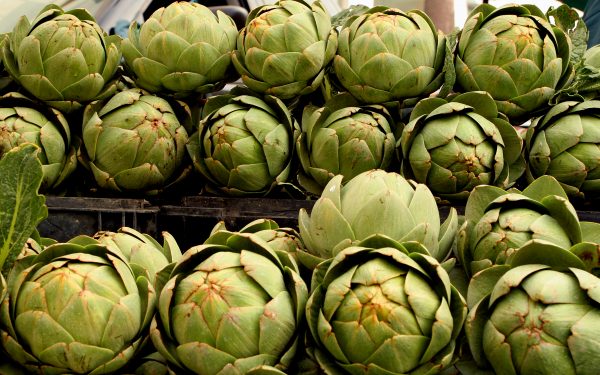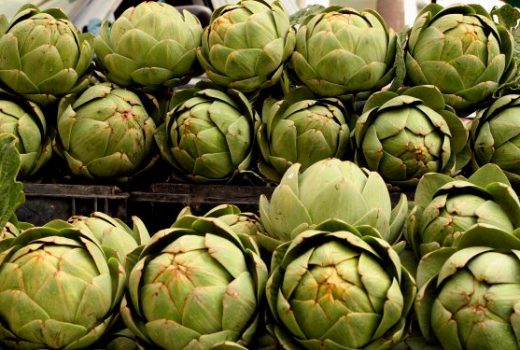| Botanical Name | Cynara scolymus |
| Plant Type | Vegetable |
| Family | Daisy |
| Time to Plant | Late summer |
| Soil Type | Sandy or loam is ideal |
| Soil Condition | Fertile, well-drained |
| Soil PH | 6.5 to 7.5 or slightly alkaline |
| Sun Exposure | Full sunlight |
| Temperature | 70 to 80 C |
| Water Supply | 1 to 3 times a week |
| Organic Matter | Add in soil |
| Fertilizers | After every two weeks |
The Artichokes, a nutritious and a perennial plant has been growing since the time of Romans, belongs to thistle which is the part of the daisy family. In this article, we will cover every possible aspect for growing artichokes plant starting from primary and essential requirements to the harvesting and storing. We will explain in details that which are the best conditions and absolute time for growing artichokes? When to plant artichokes for a maximum and healthy yield. How to plant artichokes to attain qualitative and quantitative yield? How to grow artichokes and different factors that are extremely important factor which you will have to maintain for best production. How to care your artichokes plant from harmful weather effects and pests attacks? Finally, we will explain the best time for harvesting artichokes and how to harvest artichokes?

Artichokes plant has various scientifically proven advantages like blood pressor regulation and ameliorates liver health. Furthermore, It is an elegant vegetable and delicious to eat with a buttery texture. Therefore, if you are a gardener then you must add this vegetable into your list for growing. If you are new and don’t know how to grow artichokes then read this article carefully. We will cover every aspect for planting artichokes from beginner to advance. Let’s first discuss the requirements for growing artichokes.
Requirements for growing artichokes
When growing artichokes plant you must hit the nail on the head. Any crop which grows up in a time span matching the exact conditions to grow, produce a healthy and qualitative crop. Therefore, it is crucial to know about the fundamental condition for growing artichokes.
Sunlight is a basic requirement to grow artichokes plant. It grows finest in full sunlight. So first of all, select a place where it can have full sun. Although it can tolerate somehow in slight shade, its flower buds can be affected. The best suitable temperature for planting artichokes is 70 to 80 C. The preferred climate for this plant is warm and relatively dry weather similar to Mediterranean and California.
Artichoke is a perennial plant which gives production every year after growing. You should prepare your soil attentively for the best crop. This plant requires sandy but well-drained and fertile soil. You should add different organic materials including well-rotted compost and aged manure to boost up the growth. For ideal growth, the pH of the soil should be 6.5 to 7.5 or slightly alkaline. It doesn’t require much fertilizer if you add enough organic material. If you don’t add compost at the start, you should add fertilizers slightly after every two weeks. This develops a strong root system and requires frequent water supply almost 3 times in a week.
When and how to plant artichokes?
When to plant artichokes? It’s totally depended on the region where you are planting it. It’s mostly planted during the late summer because it’s the bloom time for it. Normally, it is grown annually in zones 3 to 11. You can grow it during early spring. You will be able to harvest the crop in late summer or early fall.
So far we have covered various requisite requirements for planting artichokes which are highly recommended. Now you are familiarized about the all soil and climate condition to grow artichokes plant. Now come to the most important point of our discussion is how to plant artichokes?
- Choose a sunny place where it can have direct sunlight for a few hours.
- Select an appropriate type either green or purple (most popular types of artichokes) of artichokes for planting. We recommend that among the green, go with Imperial Star and Green Globe for annual plant and high-productive perennial respectively. If you want to grow purple artichokes then go with Violetta and Opera. Violetta is a better option in an extremely hot climate and Opera will be mature quickly.
- Make sure that your soil condition must be well-drained, moist and fertile.
- Add at least 6 inches of compost deep into the ground for best root development.
- If you belong to an area having heavy rainfall, the drainage system should be appropriate.
- You can grow artichokes plant from both seeds and seedlings. If you want to grow from seeds then sow the seed indoors. Plant almost 4 seeds in 10 cm wide container and place this container on the sunlight. At normal indoor temperature, it will take most probably a week for germination.
- Start hardening the seedling after 6 weeks before the expected last date of frost according to your era. Before anticipated frost start, move your seedling outdoor 3 to 4 weeks ago. The temperature should be below 45 F for the betterment of flower growth.
- Wait for 8 to 10 weeks. The plant should have stocky steam and a pair of leaves. If any plant doesn’t match this, dig that out from the field.
- If you have only 90 to 100 days without frost then you should go with the seedlings options. Transplantation should be in cold climate.
- Try to maintain the distance between two artichokes plants at least 3 feet. If it is possible to plant 4 to 6 feet apart then try to maintain this distance. These plants require enough room to grow because these have large and aggressive wingspan.

How to grow artichokes with plant care?
You have learned in detail the complete procedure of planting artichokes. Don’t just leave your crop after planting. You should take care of your crops to obtain maximum and healthiest yield.
Water the crop frequently. Try to avoid the soil to become waterlogged. If drainage is not appropriate then replant your crop in a raised bed.
Make sure to add the fertilizer after every two weeks. If there is a deficiency of organic material then add a balanced amount of fertilizer at the start too.
How to harvest artichokes?
You can start harvesting artichokes during the mid to late summer. Keep your eyes on the bracts (lowest scale buds), when these start opening then remove the buds. Usually, a single stalk produces 3 to 5 buds. Cut off the bud with the sharp knife almost by leaving the 3-inch stem. You can store the buds into the fridge until cooking.

